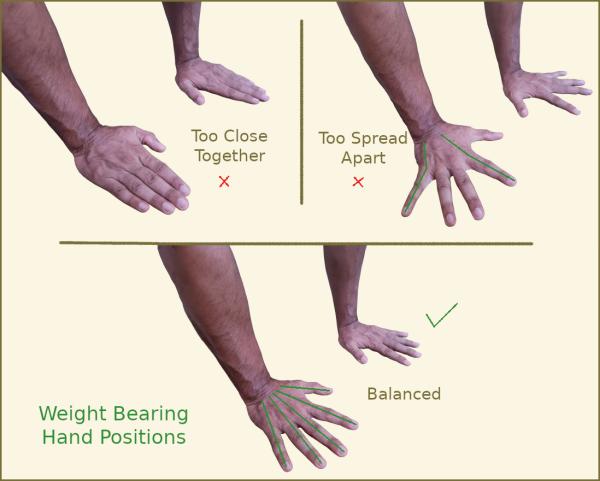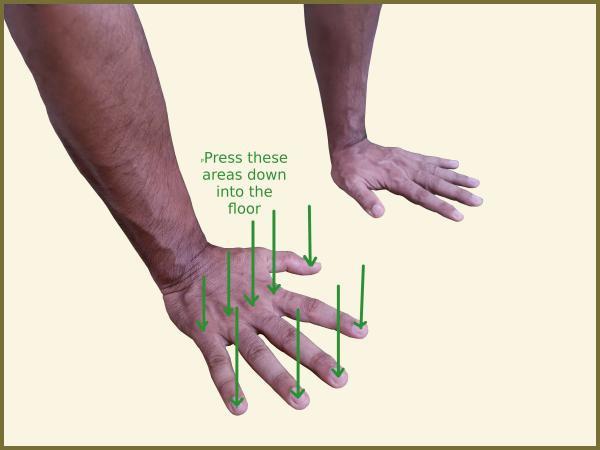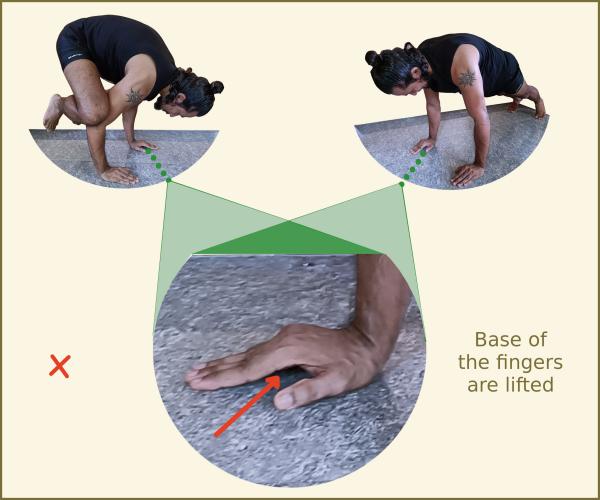Wrist pain and injuries are quite common in Yoga asana practice. There are so many postures where either the whole weight of the body is on the wrist or a part of it. Wrists are generally not used to bearing so much load. So it becomes necessary to follow proper alignment and understand the anatomy to execute the posture safely.
Small mistakes keep on accumulating over time and gradually change into an injury.
In the years of teaching the Yoga teachers training course, we have noticed bad forms in the most common postures. These postures like downward-facing dog (adho mukha svan asana), upward-facing dog (urdhva mukha svan asana), santol asana (high plank), chaturanga dandasana, etc are a part of Sun salutations (which has many variations) and are practiced very often. Because of the frequency with what we do these poses even a small misalignment can turn into a major injury over time. It’s not about that these poses are bad for you but you have to try to learn the proper way to execute these poses.
This might get into a long article, if you are patient enough we are sure you can improve your practice with the knowledge we are sharing. (especially for the new yoga teachers out there)
Alignments and tests:
Spreading and engaging the fingers: Whenever the hand is on the floor/ground, try to engage your fingers and spread them apart. Do not spread them too much, a general guide would be to check if the particular tendon on the top of your hand and its corresponding finger is relatively in a straight line. Check the photo below.

The next cue would be to press the fingers into the ground as this action will engage the forearm muscles and create more space in your joints. To understand this alignment let’s do the following experiment.
- Experiment/Test 1: Get into a tabletop position. Close your eyes and start pressing individual fingers onto the floor for 5 seconds each, starting with the first finger, the middle finger, the ring finger, the little finger, and the thumb.
- Observation and learning: when you press the different fingers you will observe the corresponding muscles working on your forearm. Each of the tendons of the finger is connected to a different muscle in the forearm and as you engage the particular finger a different region in the forearms gets engaged. So if you want the force to travel equally into your forearms then engage the fingers properly.
- Conclusion: Each of the fingers is connected to a different muscle in the forearm via tendons, for the weight to be distributed equally engage the fingers equally.

Relaxed unengaged hands and arms vs the engaged: The wrist joint is a synovial joint, filled with the synovial fluid which acts as a cushion between the bones and decreases the friction during movement. This fluid is surrounded by a membrane (synovial membrane, bursae) around the joint.
The bones are for support and the muscle are for strength and stability. When you engage the muscles then they take the load off the bones and if you don’t then it might squash your joints. To understand these better let’s do another experiment.
- Experiment/Test 2: In the tabletop position close your eyes and press all the fingers together on the floor. Observe what is happening in your body, observe the forearms, shoulders, and core. Now relax the fingers and just be in the posture without any muscle engagement. Observe your body now and compare it with the engaged position
- Observation: When you press the fingers into the ground you will see that your body gets slightly lifted up. the forearms, the shoulders, and the core will be engaged. This upwards force will create more space in the joints and keep the joints healthy. When you sink into the posture (unengaged muscles) then you will observe that there is more pressure in the joints (mostly the wrist), this can decrease the gap in the joint and put more strain on it and gradually change into some kind of pain or injury.
- Conclusion: Engaging and pressing each of the fingers into the ground will also engage the forearms, shoulder muscles, and core and lift the body creating space in the joints.
Some people (after years of practice with no proper alignment) develop a condition called Ganglion cyst which is a lump of a fluid-filled sac mostly around the wrist joint. A possible reason for this could be the pressure on the joint which pushes the fluid and the membrane gets bulged (we don’t have any data to back this up, this is just our logical theory).
Another problem that they develop is bursitis, which is an inflammation of these same sacs/membrane.
These lumps and inflammation start taking up space and start touching some nerves which start causing pain.
We are not trying to scare you, just asking you to be aware in your practice.
Injuries definitely teach us something but a smart learner would be the one who learns without getting one.
Another very important alignment
Well, it is easy to engage the hands in a simple posture (like the tabletop) but what about when the weight on the arms is more in postures like chaturanga dandasana (pushups) and the high plank pose. From our teaching experience, we have seen that there are certain tendencies in these poses. The first one is not engaging the fingers properly (which we have already talked about) and the second one is the base of the finger lifting up and people make a cup kind of shape with the hand (check the photo below).

As the weight increases on the wrist and forearms, a greater engagement of the muscles will be required by you to counteract that weight. Our muscles are for generating strength and the bones are for support. The mistake that we do is we sink into the posture, not engaging the muscles properly and relying on the bones. If the posture is difficult then it might become a little harder to engage the muscles, as a result, the base of the finger lifts up and all the weight shifts unevenly on the outside of the wrist joint (which is not good for the wrist joint). So be extra aware of your chaturanga dandasana, high plank, the crow pose, and other arm balancing poses.
As a general rule, if you pay extra attention to the hands and the feet which are in contact with the floor and engage them properly then you can be sure that most of the other muscles will automatically start working. And if you add proper core engagement to it, the body will automatically take care of most alignments.
Now that you know the hand alignment check our arm balancing posture library.
